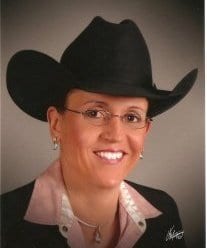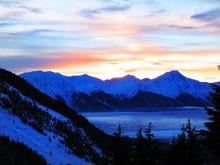While Alaska is largely associated with popular annual events like the Iditarod Trail Sled Dog Race that starts in Anchorage and ends in Nome, it is exciting to know that Open and AQHA horse shows are frequently held in the state. AQHA judge Lita Hottel recently judged a show in Fairbanks, Alaska and AQHYA World Champion exhibitor Danielle Long is from Anchorage, Alaska and we wondered what it is like showing and judging in this state.
To start off, here are some fascinating facts about the territory. Alaska has a longer coastline than all the other U.S. states combined. It is the largest state in the United States in land area at 586,412 square miles which is over twice the size of Texas–the next largest state. Alaska was purchased from the Russian Empire on March 30, 1867, for $7.2 million at about two cents per acre, and it also became the 49th state of the U.S. on January 3, 1959.
Along with those facts, native Alaskan Danielle Long shared some local customs. “Most Alaskans love their salmon. Everybody goes fishing at some point during the summer to stock their freezers for the winter. We also have some different words (than mainland US) such as ‘bush’ which is our word for ‘the middle of nowhere Alaska.’ The ‘slope’ which is anything north of the Arctic Circle, and the ‘lower 48’ which is the 48 states below Alaska.”
As far as what it is like showing in Alaska–Long explains that the shows in Alaska are smaller. “Almost everybody shows in all the events because there are so few that it goes quick. Everybody knows each other and we all help each other out. We do have our ‘serious show people’ and ones that are there just there to have fun,” Long said. “There is mostly outdoor pens. The show season is from the end of May to August. The shows start at 8 am and usually we get done with everything by 5 pm. Leaving us time to have BBQ bonding time.”
A former Junior Olympic downhill skier, Long adds that Alaska is also a great place for outdoor sports. “Four years ago I used to downhill ski race before I fell in love with the (out of state) horse showing. I was on the Alaska Ski Team and made it to the Junior Olympics twice. Unfortunately, we had some bad luck both times though. I still ski, just not competitively.” Danielle adds, “My favorite thing to do is hike. You can do it all year round and the scenery is awesome no matter where you are. There are hiking trails minutes from my house, which is convenient. It is a great place to live. There is wildlife everywhere and always some mountain or new place to explore. The only downside is that it is a whole country away from the rest of the US.”
What is unusual about Alaska is that during the summer they get about 19 hours of sun a day and only about five hours of sunlight during the winter. “You really don’t notice the light changing when you stay in the state,” 17 year-old Long explains. “When I travel to other places I notice though. And if you are not originally from Alaska if you visit in the middle of summer or winter its a really big difference from the US. It can be a little challenging trying to go to bed at 11pm and the sun is still showing!”
 AQHA judge Lita Hottel (pictured left) also mentioned that it was a challenge trying to go to sleep with it still daylight. “Fairbanks is fairly close to the Arctic Circle and in late June it was light almost all the time. That can and did interfere with sleep. Being three time zones west of home meant we were awake at three a.m. and drowsy by seven p.m. We also covered the windows with plastic garbage bags to block out the sunlight to try and get to sleep faster.”
AQHA judge Lita Hottel (pictured left) also mentioned that it was a challenge trying to go to sleep with it still daylight. “Fairbanks is fairly close to the Arctic Circle and in late June it was light almost all the time. That can and did interfere with sleep. Being three time zones west of home meant we were awake at three a.m. and drowsy by seven p.m. We also covered the windows with plastic garbage bags to block out the sunlight to try and get to sleep faster.”
Alaskans don’t show their horses in just one event like many do in the lower 48 states, Hottel said. “There are not many trainers in this part of the country, so, they are really excited to learn more about showing. I held a clinic after the show to give some pointers to several of the riders. Their horses also are used for other purposes like trail riding, hunting, and their handicapped riding program. They love their horses and want to have a good time. They are interested in learning and love to laugh.”
Hottel adds, “The weather was constantly changing throughout the whole day during the show. It was wild, but it would be hot, cold, and rainy at some point during the day. The show management would already be prepared for all types of weather changes and have the attire needed for us to change into.”
 Lita and her family also had the opportunity to go sight seeing nearby.“We went down south to Denali National Park, east to Chena Hot Springs, and north to the Yukon River and Circle City,” Hottel said. “My husband and I went kayaking. He and our daughter went fishing. All of us went moose watching and took in a gold mining tour. Now our daughter wants to quit the fifth grade and pan for gold in Alaska! There is a lot to do and see in the Fairbanks region.”
Lita and her family also had the opportunity to go sight seeing nearby.“We went down south to Denali National Park, east to Chena Hot Springs, and north to the Yukon River and Circle City,” Hottel said. “My husband and I went kayaking. He and our daughter went fishing. All of us went moose watching and took in a gold mining tour. Now our daughter wants to quit the fifth grade and pan for gold in Alaska! There is a lot to do and see in the Fairbanks region.”
Hottel also mentions the intriguing fact that everyone can carry a fire arm in Alaska–even children 16 and under with their parents permission. “There were a lot of road signs shot up and all the men appeared to be wearing beards. My husband even grew one while we were there,” Lita said. “He also tried a reindeer omelet one morning for breakfast, and we saw several moose crossing the roads and several came up real close to us.”
Lita adds, “It was definitely an experience I will never forget. I am thankful to be involved with horses because I probably would have never had the opportunity to travel to so many interesting and exotic places like Alaska if it wasn’t for horses.”









